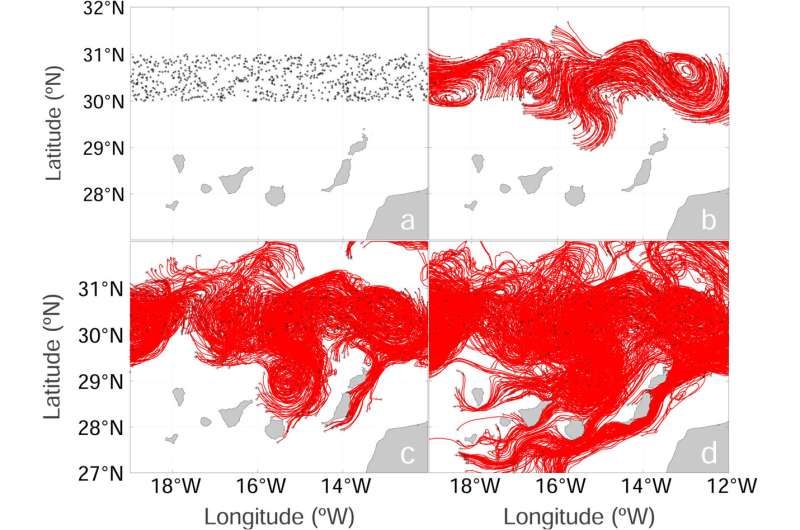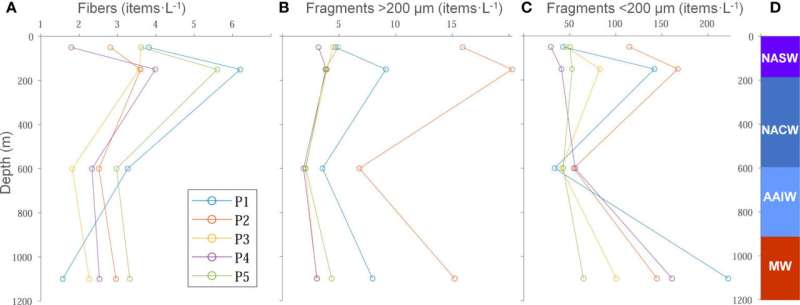February 21, 2024 feature
This article has been reviewed according to Science X's editorial process and policies. Editors have highlighted the following attributes while ensuring the content's credibility:
fact-checked
peer-reviewed publication
trusted source
proofread
Marine microplastics: How water mass dispersal impacts transport trajectories

Marine microplastics (1 μm–5 mm diameter) are an ever-pressing concern, given their longevity in the environment (>100 years) and the effects they have on the organisms inhabiting them, particularly as ocean currents carry the particles vast distances, even reaching polar basins.
Often these microplastics wash up on beaches and mix in with the sandy shores familiar to us, but certain zones have become particular hot spots for microplastic pollution. Famously there are "garbage patches" associated with the five subtropical ocean gyres (circular currents in the North and South Atlantic Ocean, North and South Pacific Ocean and Indian Ocean) that have millions of km2 area of floating surface microplastics.
Previous studies have suggested that 15.6 trillion particles/year are added to the global floating marine debris crisis.
New research published in Frontiers in Marine Science has focused on the beaches of the Canary Islands, popular Spanish tourism resorts, investigating the potential origin and transport pathways of microplastics both across ocean basins and through the water column, until they ultimately wash ashore on these beaches.
Significantly, the Canary Islands are located within the North Atlantic subtropical gyre, as well as the direct path of the surface wind-driven Canary Current. Four north to north east-oriented beaches across the archipelago were studied for large-scale (>100 km) and meso-scale (10–100 km) transport mechanisms, these being: Playa Grande (Tenerife), Playa de Famara (Lanzarote), Playa Lambra (La Graciosa) and Arenas Blancas (El Hierro).
These beaches are known for marine debris issues, exceeding 100 g plastic/m2 and 3,000 particles/m2.
Dr. Daura Vega-Moreno, Assistant Professor at Universidad de Las Palmas de Gran Canaria, Spain, and colleagues focused particularly on the velocity of currents in the 27°–32 °N latitude range over a multi-year period, and how this impacted marine debris transport through the water column in the open ocean.
An open-ocean focus is important as factors affecting microplastic transport differ from those along coastlines, where the latter generally relates to density, size and shape, therefore being sorted by wind and waves with the smallest and lightest material being carried further inland.
Conversely, for open waters, the internal composition of the plastic and its state of degradation play additional important roles, as well as water column temperature, convection and the Coriolis effect (air deflected to the right in Northern Hemisphere and left in Southern Hemisphere).
The research team used data from numerous projects where microplastic particles were released into the ocean since 2017, monitoring progress using marine-based technologies as well as direct sampling of the water column during a research cruise.
After processing, a microscope was then used to identify each type of marine debris, totaling 260 microplastic fragments and fibers. All of this data was subsequently used in modeling software to determine the trajectories from source to beach sink and produce distribution maps.

Dr. Vega-Moreno and colleagues identified 200 m water depth as a key accumulation window for both fragments and fibers, while 1,100 m water depth is a critical point for high accumulation of fragments both <200 μm and >200 μm. While the former may be due to natural sinking through the water column, the latter is likely partially linked to the flow of Mediterranean Water, the high-salinity outflow from the Strait of Gibraltar.
This water mass sinks below the North Atlantic Central Water to the seafloor in the Atlantic Basin to depths of 1,000–1,200 m and disperses towards the Canary Islands. The Mediterranean Sea from which the water originated is known to have a high concentration of both large plastic pieces and microplastics, with estimates of up to 10% of global marine plastic pollution being in the Mediterranean Basin alone.
Small microplastics (<1 mm) and those that are flattened or degraded are likely to be entrained in this descending water mass and therefore carried vast distances across the ocean basin at depth.
Assessing the transport pathways of marine microplastics and therefore where they may wash ashore is important for targeted removal techniques, as well as mitigating the consequences on marine and coastal biota. This research highlights the role deeper water masses have to play in dispersing plastic pollution, thus further work on the locations of intermediate (~1,000 m) to deep water (>2,000 m) formation is vital, especially as this includes polar regions.
More information: Daura Vega-Moreno et al, Exploring the origin and fate of surface and sub-surface marine microplastics in the Canary Islands region, Frontiers in Marine Science (2024). DOI: 10.3389/fmars.2024.1314754
Journal information: Frontiers in Marine Science
© 2024 Science X Network



















